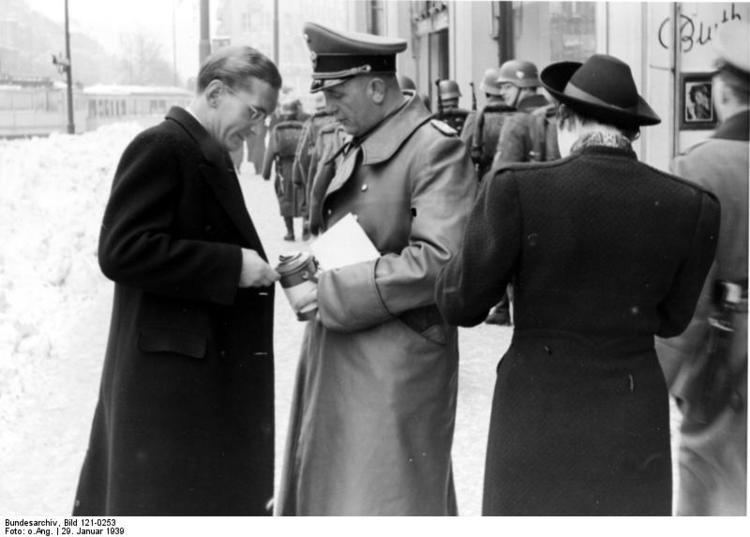Years of service 1914–1941 | Name Arthur Mulverstedt | |
 | ||
Born 30 June 1894
Gebesee, Province of Saxony, Kingdom of Prussia, German Empire ( 1894-06-30 ) Died 10 August 1941(1941-08-10) (aged 47)
Luga, Leningrad Oblast, Russian SFSR, Soviet Union Allegiance German Empire (to 1918)
Weimar Republic (to 1933)
Nazi Germany Service/branch Reichsheer
Ordnungspolizei
Waffen SS Rank Gruppenfuhrer und General der Polizei und Waffen-SS Unit 4th SS Polizei Division | ||
Arthur Mulverstedt (30 June 1894 – 10 August 1941) was a SS-Gruppenfuhrer und Generalleutnant der Schutzpolizei during World War II; he was a Commander of the 4th SS Polizei Division and the first SS General to be killed in action.
Contents
Early life
Mulverstedt was born on 30 June 1894 in Gebesee near Erfurt, Thuringia. After completing school, he became a Fahnenjunker in the 29 Infantry Regiment “von Horn” in March 1914.
World War I
The 29th Infantry Regiment “von horn” was a component of the 16th Infantry Division which was deployed on the Western Front. The regiment saw action at the battles of the Marne and the Somme. It was transferred to the Eastern Front briefly before returning to the Western Front to see out the war. During this time Mulverstedt was promoted to Leutnant on 14 March 1915 and then to Oberleutnant on 20 June 1918. This rank he kept until the end of the war. He was wounded twice during the conflict.
Interwar period
After the war, Mulverstedt joined the Sicherheitspolizei on 15 September 1919 (later redesignated the Schutzpolizei) as a Hauptmann, and was assigned to posts in Berlin, Eiche, and Erfurt.
He married Anne Klagges on 14 May 1921 (she was born 30 October 1896 in Leer, Ostfriesland; but was killed in an Allied air raid on Berlin on 6 March 1944); they had three children, a son – Claas and two daughters – Inge and Marie Luise.
Mulverstedt joined the Nazi party on 30 July 1932 (Membership number 1 331 860). He was transferred from the Schutzpolizei to the Landespolizei in 1933 and was the Commander of the Hannover Gruppe until March 1935. In March 1935 he left the Landespolizei and joined the Reichsheer as a Staff Officer with the 102nd Infantry Regiment, he then became the Commander of the 1st Btn of the 68th Infantry Regiment until 1 October 1936.
After this spell in the army Mulverstedt returned to the Schutzpolizei service as the Deputy to the General Inspector, Theodor Siebert. He then succeeded to the post of Generalinspekteur der Schutzpolizei des Reiches on 20 April 1937. This is a post he held concurrently with his SS ranks until March 1940.
Mulverstedt joined the SS on 20 April 1938 (SS service number 292 712) and was attached to the staff of the Reichsfuhrer-SS with the rank of Oberfuhrer. In 1938 he became the Commander of Schutzpolizei Abschnitt III for the annexations of Austria and the Sudetenland .
World War II
Mulverstedt's World War II service began as the Commander of Polizeigruppe 5 which was attached to the 4th Army for the invasion of Poland. He then became the Commander of the Wandern Training Area from 31 March to 10 November 1940.
On 9 November 1940 he was promoted to the rank of SS-Gruppenfuhrer and was appointed the divisional commander of the 4th SS Polizei Panzergrenadier Division after Karl Pfeffer Wildenbruch had returned to the staff of the Reichsfuhrer. In this period the division was transferred from Police to SS administration.
Mulverstedt led the division during Operation Barbarossa (the invasion of the Soviet Union), where it was in action in the Army Group North sector. In August 1941 the division was fighting with 269th Infantry Division against the Soviet forces to take the town of Luga. During the fighting, Mulverstedt was killed in action by artillery fire on 10 August 1941.
Awards and decorations
World War I
World War II
